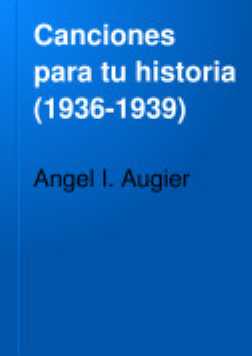4.1.1.20.1 The poetry collection “Songs for your history”, 1941, by Angel Augier (1910 – 2010)

The collection of poems “Songs for Your Story,” published in 1941 by Ángel Augier, is a hymn to love that combines feeling and fulfillment, the approach of the poet’s self to his beloved, while at the same time delving into the lyrical speaker’s own subjectivity, whose doors open before the impetus of love, and establishing a link of strong colloquial sign with the receptacle of the love of the subject who sings.
The text consists of twenty-four poems, distributed in five sections, which create a linear story from the discovery of love to its fulfillment, with nuances associated with both the spiritual and the eroticism of carnal passion. The author recreates the emotional states aroused by the experience of love, and indeed, love, in terms of the contact established between the dyad of beings.
Although it doesn’t appear to conceal a Kabbalistic symbolism, the number of twenty-four itself is suggestive in terms of potential readings, as is the number of seven poems that make up the second section, each relating to a day of the week when the beloved is absent. These poems anchor a sentimental framework in which hesitation and nostalgia intertwine, sometimes acquiring hints of despair.
The remaining sections allude to reciprocated love and its full carnal fulfillment, in which the spiritual was also present. The lyricism of these verses has a clear neo-romantic influence; although it also reflects a linguistic and tropological experimentation typical of the poetic avant-garde, which had not yet lost its sway.
However, not all of the collection of poems lends itself to lexical play, as it also contains the more classical forms that the feeling of love had traditionally adopted, as reflected in the sonnet that serves as the colophon of the fourth section, in which the spiritual and the carnal participate in the dazzling aftermath of ecstasy, simply titled “Sonnet”:
“I continue, Love, with my unbridled joy
your career along paths of honey,
traveling with your flames and your wounds
from the exact contour of your sphere.
I have the pulse of countless lives
in your profile biased in your own way
as your strength has grasped
the bells in the sun of my flag.
For an eternity caressed
arrive naked and clean your figure
at the edge of my loving light,
and in the blue window of my fortune
your kiss, Love, your voice and your look
watching over my wakefulness of tenderness”
Beyond the hackneyed nature of the topic and its successful, but not unique, treatment, one of its most interesting achievements is the social significance it largely attributes to the feeling of love, a plenitude that blossoms beyond the couple to inject a certain dose of energy that perhaps lyrical expression can convey; but above all, in the experiential sense that surpasses them and somehow impacts the social environment:
“Let us transform desire into muscle and song
in defense of so many clamorous flags:
Let us save that overflowing blood, (…)
(…)
Only in its powerful saving current
our star will find its course,
woman of honey and crystals.”








